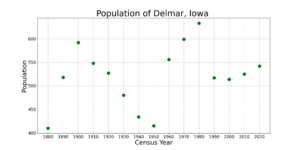Delmar, Iowa facts for kids
Quick facts for kids
Delmar, Iowa
|
|
|---|---|

Chicago, Milwaukee, St. Paul & Pacific Depot
|
|

Location of Delmar, Iowa
|
|
| Country | United States |
| State | Iowa |
| County | Clinton |
| Area | |
| • Total | 0.76 sq mi (1.98 km2) |
| • Land | 0.76 sq mi (1.98 km2) |
| • Water | 0.00 sq mi (0.00 km2) |
| Elevation | 820 ft (250 m) |
| Population
(2020)
|
|
| • Total | 542 |
| • Density | 709.42/sq mi (273.88/km2) |
| Time zone | UTC-6 (Central (CST)) |
| • Summer (DST) | UTC-5 (CDT) |
| ZIP code |
52037
|
| Area code(s) | 563 |
| FIPS code | 19-19720 |
| GNIS feature ID | 0455873 |
Delmar is a city in Clinton County, Iowa, United States. The population was 542 at the time of the 2020 census.
History
Delmar was platted in 1871, shortly after the railroad was built through the site. The name Delmar is said to be a combination of the initials of the six ladies on the first train to arrive into the station: Della, Emma, Laura, Marie, Anna, and Rose. Le Mars, Iowa was similarly so named.
Geography
Delmar is located at 42°0′6″N 90°36′28″W / 42.00167°N 90.60778°W (42.001744, -90.607683).
According to the United States Census Bureau, the city has a total area of 0.76 square miles (1.97 km2), all land.
Demographics
| Historical populations | ||
|---|---|---|
| Year | Pop. | ±% |
| 1880 | 410 | — |
| 1890 | 518 | +26.3% |
| 1900 | 592 | +14.3% |
| 1910 | 548 | −7.4% |
| 1920 | 527 | −3.8% |
| 1930 | 480 | −8.9% |
| 1940 | 434 | −9.6% |
| 1950 | 415 | −4.4% |
| 1960 | 556 | +34.0% |
| 1970 | 599 | +7.7% |
| 1980 | 633 | +5.7% |
| 1990 | 517 | −18.3% |
| 2000 | 514 | −0.6% |
| 2010 | 525 | +2.1% |
| 2020 | 542 | +3.2% |
| Source: and Iowa Data Center Source: |
||
2020 census
As of the census of 2020, there were 542 people, 208 households, and 147 families residing in the city. The population density was 709.3 inhabitants per square mile (273.9/km2). There were 213 housing units at an average density of 278.8 per square mile (107.6/km2). The racial makeup of the city was 89.3% White, 4.2% Black or African American, 0.6% Native American, 0.0% Asian, 0.0% Pacific Islander, 0.7% from other races and 5.2% from two or more races. Hispanic or Latino persons of any race comprised 2.2% of the population.
Of the 208 households, 35.6% of which had children under the age of 18 living with them, 53.4% were married couples living together, 10.1% were cohabitating couples, 21.6% had a female householder with no spouse or partner present and 14.9% had a male householder with no spouse or partner present. 29.3% of all households were non-families. 23.1% of all households were made up of individuals, 11.5% had someone living alone who was 65 years old or older.
The median age in the city was 35.9 years. 31.4% of the residents were under the age of 20; 6.5% were between the ages of 20 and 24; 22.5% were from 25 and 44; 23.8% were from 45 and 64; and 15.9% were 65 years of age or older. The gender makeup of the city was 48.0% male and 52.0% female.
2010 census
As of the census of 2010, there were 525 people, 213 households, and 145 families living in the city. The population density was 690.8 inhabitants per square mile (266.7/km2). There were 227 housing units at an average density of 298.7 per square mile (115.3/km2). The racial makeup of the city was 97.0% White, 1.5% African American, 0.2% Native American, 0.2% Asian, and 1.1% from two or more races. Hispanic or Latino of any race were 1.5% of the population.
There were 213 households, of which 33.8% had children under the age of 18 living with them, 54.0% were married couples living together, 8.0% had a female householder with no husband present, 6.1% had a male householder with no wife present, and 31.9% were non-families. 28.6% of all households were made up of individuals, and 12.6% had someone living alone who was 65 years of age or older. The average household size was 2.46 and the average family size was 3.03.
The median age in the city was 38.5 years. 27% of residents were under the age of 18; 5.5% were between the ages of 18 and 24; 27.1% were from 25 to 44; 24.8% were from 45 to 64; and 15.6% were 65 years of age or older. The gender makeup of the city was 49.7% male and 50.3% female.
Education
Delmar and Elwood Schools consolidated in 1962 to form the Delwood Community Schools. Delwood began whole-grade sharing with nearby Maquoketa in the 1980s, Students in grades 7-12 attend Maquoketa, while grades Pre-K through 6 remain at the Delwood School in Delmar.
See also
 In Spanish: Delmar (Iowa) para niños
In Spanish: Delmar (Iowa) para niños


